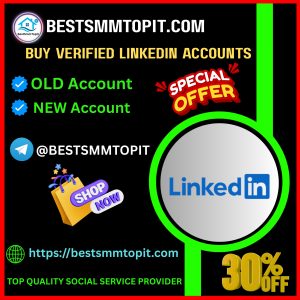Buy Twitter Accounts
In the digital arena where influence dictates reach and perception shapes power, Twitter has emerged as a commanding force. A single tweet can catalyze conversations, launch brands into the stratosphere, or implode reputations in real-time. With over 450 million active users, Twitter is not just another social media platform—it’s a global forum, a PR machine, and a digital goldmine. This compelling dynamic has birthed a growing market trend: businesses and individuals increasingly buy Twitter accounts to gain a competitive edge.
But why are people so eager to invest in established Twitter profiles, and what are the implications? This guide delves into the intricacies of purchasing Twitter accounts, exploring the motives, risks, rewards, and the shadow economy that fuels this practice.
The Rise of Twitter as a Business Asset
Twitter is more than a social echo chamber. It’s an agile marketing tool that delivers immediate access to audiences across industries—politics, tech, fashion, finance, and more. Unlike platforms that rely heavily on algorithmic filtering, Twitter rewards engagement, immediacy, and authenticity. A single retweet from an account with a large following can trigger a ripple effect, bringing visibility, credibility, and revenue.
That’s where the strategic advantage of buying Twitter accounts comes into play.
Why Businesses Buy Twitter Accounts
- Instant Credibility and Social Proof
Building an audience organically takes time and effort. For new brands or entrepreneurs, the barrier to entry can be high. Buying an account with thousands—or even millions—of followers allows them to bypass this arduous process. It provides instant credibility in the eyes of potential customers, investors, and collaborators. - Algorithmic Leverage
Twitter’s algorithm favors content from accounts with higher engagement rates and a history of consistent activity. A newly created account lacks this historical data, making it harder to gain traction. Pre-owned accounts with established footprints perform better in terms of reach and interaction. - Niche Audience Access
Accounts focused on specific topics—such as crypto, gaming, beauty, or politics—come with niche audiences already interested in that content. Businesses can plug directly into these communities without starting from scratch. - Brand Expansion or Rebranding
Some businesses purchase accounts to facilitate mergers, regional expansions, or strategic rebrands. A company entering a new market might buy Twitter accounts from influencers in that locale to fast-track its regional visibility. - Monetization Opportunities
Monetized Twitter accounts can generate income through sponsored posts, affiliate marketing, and product promotion. Buying such an account is akin to acquiring a pre-leased billboard on a high-traffic highway.
The Shadow Market: How the Trade Works
The marketplace for Twitter accounts is largely underground, operating through private forums, encrypted messaging platforms, and invitation-only marketplaces. Sellers list accounts based on metrics like follower count, engagement rate, niche, and account age. Premium accounts—especially those with a verified badge—can command high prices.
Payment is often made through digital currencies or platforms like PayPal. Here, another often-associated practice emerges—buyers also buy verified PayPal accounts to facilitate secure, anonymous transactions without linking their personal identity.
Buying verified PayPal accounts has become commonplace in this gray market to avoid triggering fraud alerts or transaction restrictions, especially when moving large sums internationally. These accounts also allow for seamless interaction with marketplaces and freelance escrow services.
Red Flags and Risks
Despite the apparent advantages, buying Twitter accounts is not without peril. Several legal, ethical, and technical concerns loom large.
- Violation of Twitter’s Terms of Service
Purchasing or selling Twitter accounts directly contravenes the platform’s terms. If detected, Twitter may suspend or permanently ban the account, rendering your investment worthless. - Fake Followers and Bots
Not all that glitters is gold. Many accounts boast inflated follower counts composed of bots or inactive users. These ghost audiences offer no real engagement and can damage your brand’s reputation when discovered. - Security Compromises
Pre-owned accounts are more vulnerable to hacking and phishing, especially if the original owner retains some access or if credentials are reused across platforms. - Reputation Management Challenges
The digital footprint of a Twitter account persists. Old tweets, controversial opinions, or problematic interactions could resurface and taint your brand, even after a rebrand or content overhaul. - Transaction Scams
The anonymity of these transactions makes them fertile ground for fraud. Sellers might disappear after receiving payment or provide accounts that are quickly suspended. Here again, many turn to buy verified PayPal accounts to access escrow services or dispute resolution mechanisms that offer some level of protection.
Legal and Ethical Considerations
From a legal standpoint, the purchase of social media accounts occupies a gray area. While not inherently illegal, it can breach contracts or service agreements. More importantly, it raises questions about authenticity, transparency, and trust. Brands built on borrowed identities may struggle to connect with their audience on a genuine level.
In regulated industries like healthcare, finance, or education, the stakes are even higher. Regulatory bodies could view the use of pre-owned digital assets as deceptive or non-compliant with communication standards.
Best Practices: If You Must Buy
While the official advice is to grow your following organically, for those who choose to buy Twitter accounts, several best practices can mitigate risk:
- Vet the Seller
Use reputable brokers or marketplaces with verified transactions and customer reviews. - Audit the Account
Run analytics to verify engagement rates, follower authenticity, and niche alignment. Tools like Twitter Audit or Followerwonk can be useful. - Secure the Transition
Change all credentials, enable 2FA, and unlink any connected services post-purchase. - Scrub the Content
Remove any potentially damaging content. Use automated tools or manual reviews to clean the timeline. - Blend, Don’t Break
Transition gradually. Sudden shifts in content, tone, or branding may alert Twitter or alienate followers. - Use Secure Payment Channels
This is where many choose to buy verified PayPal accounts, allowing them to transact with greater flexibility and anonymity while accessing dispute resolution if needed.
The Economics Behind the Trend
The cost of a Twitter account varies wildly. A small niche account with 5,000 real followers might sell for a few hundred dollars, while a blue-check, high-engagement profile could fetch five figures. When you compare this to the cost of building and managing a professional social media presence from scratch—including hiring content strategists, designers, and community managers—the upfront investment can seem justified.
Furthermore, if paired with an established eCommerce backend or influencer marketing campaign, the ROI can be substantial. It’s akin to buying prime real estate in a high-traffic district—ready for monetization from day one.
Final Thoughts
The practice of buying Twitter accounts illustrates a broader truth about the modern digital landscape: perception often precedes reality. In a world where influence is currency, acquiring it—legally or otherwise—has become a viable strategy.
However, the smarter long-term play still lies in building real engagement, fostering community, and nurturing your brand voice. Buying an account might give you a head start, but sustaining the momentum requires authenticity, consistency, and strategy.






Reviews
There are no reviews yet.